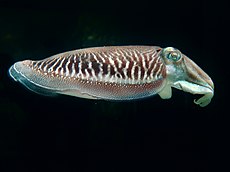ชั้นเซฟาโลพอด
| ชั้นเซฟาโลพอด ช่วงเวลาที่มีชีวิตอยู่: ยุคแคมเบรียนตอนปลาย – ปัจจุบัน;[1] อาจปรากฏตั้งแต่ยุคแคมเบรียนตอนต้น[2] | |
|---|---|

| |
| เซฟาโลพอดที่มีชีวิตและสูญพันธุ์ ตามเข็มนาฬิกาจากบนซ้าย: หมึกยักษ์สามัญ (Octopus vulgaris), Caribbean reef squid (Sepioteuthis sepioidea), หอยงวงช้างมุก (Nautilus pompilius), Orthosphynctes, Clarkeiteuthis conocauda และหมึกกระดองสามัญ (Sepia officinalis) | |
| การจำแนกชั้นทางวิทยาศาสตร์ | |
| โดเมน: | ยูแคริโอต Eukaryota |
| อาณาจักร: | สัตว์ Animalia |
| ไฟลัม: | มอลลัสกา Mollusca |
| ไฟลัมย่อย: | Conchifera Conchifera |
| ชั้น: | Cephalopoda Cephalopoda Cuvier, 1797 |
| ชั้นย่อย | |
| |
เซฟาโลพอด (ชื่อวิทยาศาสตร์: cephalopod) เป็นสมาชิกของมอลลัสกาในชั้น เซฟาโลโพดา (ชื่อวิทยาศาสตร์: Cephalopoda; จากรูปพหุพจน์กรีก κεφαλόποδες, kephalópodes; "หัว-เท้า")[3] เช่น หมึกกล้วย, หมึกสาย, หมึกกระดอง หรือหอยงวงช้าง สัตว์น้ำเหล่านี้มีร่างกายสมมาตรแบบครึ่งซีก หัวที่โดดเด่น และชุดแขนหรือหนวด (muscular hydrostat) ที่ดัดแปลงจากส่วนเท้ามอลลัสกาแบบดั้งเดิม ชาวประมงบางส่วนเรียกเซฟาโลพอดเป็น "inkfish" เนื่องจากพวกมันสามารถพ่นหมึกออกมาได้ การศึกษาเซฟาโลพอดอยู่ในสาขาของสังขวิทยาที่มีชื่อว่า teuthology
จำนวน
[แก้]มีชนิดเซฟาโลพอดแบบขยายมากกว่า 800 ชนิด[4] แม้ว่าจะยังมีการระบุถึงชนิดใหม่ต่อไป โดยมีการระบุชนิดที่สูญพันธุ์ประมาณ 11,000 ชนิด แม้ว่าร่างกายที่นิ่มของเซฟาโลพอดจะทำให้การกลายเป็นฟอสซิลเป็นไปได้ไม่ง่าย[5]
เซฟาโลพอดสามารถพบได้ในมหาสมุทรทุกแห่งบนโลก ไม่มีชนิดใดที่อาศัยในน้ำจืดได้ แต่ Lolliguncula brevis ที่พบในอ่าวเชซาพีกเป็นข้อยกเว้นบางส่วน เนื่องจากสามารถอาศัยในน้ำกร่อยได้[6] คาดว่าเซฟาโลพอดไม่สามารถอาศัยในน้ำจืดได้ด้วยข้อจำกัดทางชีวเคมีหลายประการ และในช่วง >400 ล้านปีที่มีชีวิตอยู่ พวกมันก็ไม่เคยเข้าไปอาศัยอยู่ในบริเวณที่เป็นน้ำจืดสมบูรณ์เลย[7]
การจัดจำแนก
[แก้]




การจัดจำแนกดังรายชื่อข้างล่างนี้ (รวมไปถึงบทความของสัตว์ในกลุ่มเซฟาโลพอด) เป็นไปตาม การจัดจำแนกของเซฟาโลพอด (Current Classification of Recent Cephalopoda) (พ.ค. 2544) (อังกฤษ) รวมไปถึงฟอซซิลจากหลายแหล่ง ในวงเล็บหมายถึงกลุ่มที่สูญพันธุ์ไปแล้ว
ชั้น Cephalopoda
- ชั้นย่อย Nautiloidea: เซฟาโลพอดทุกชนิดยกเว้นแอมโมนอยด์และโคลอยด์
- (อันดับ Plectronocerida): บรรพบุรุษของเซฟาโลพอดจากยุคแคมเบรียน
- (อันดับ Ellesmerocerida): รวมบรรพบุรุษของเซฟาโลพอดยุคหลัง
- (อันดับ Endocerida)
- (อันดับ Actinocerida)
- (อันดับ Discosorida)
- (อันดับ Pseudorthocerida)
- (อันดับ Tarphycerida)
- (อันดับ Oncocerida)
- อันดับ Nautilida: หอยงวงช้างและฟอซซิล
- (อันดับ Orthocerida)
- (อันดับ Ascocerida)
- (อันดับ Bactritida): รวมบรรพบุรุษของแอมโมนอยด์และโคลอยด์
- (ชั้นย่อย Ammonoidea): แอมโมไนต์และอื่น ๆ ที่เกี่ยวข้องที่สญพันธุ์ไปแล้ว
- (อันดับ Goniatitida)
- (อันดับ Ceratitida)
- (อันดับ Ammonitida): แอมโมไนต์แท้
- ชั้นย่อย Coleoidea
- (Cohort Belemnoidea): เบเลมไนต์และอื่น ๆ ที่เกี่ยวข้องที่สญพันธุ์ไปแล้ว
- (Genus Jeletzkya)
- (อันดับ Aulacocerida)
- (อันดับ Phragmoteuthida)
- (อันดับ Hematitida)
- (อันดับ Belemnitida)
- Cohort Neocoleoidea
- อันดับใหญ่ Decapodiformes (รู้จักกันในชื่อ Decabrachia หรือ Decembranchiata)
- อันดับใหญ่ Octopodiformes (รู้จักกันในชื่อ Vampyropoda)
- อันดับ Vampyromorphida: Vampire Squid
- อันดับ Octopoda: หมึกยักษ์
- (Cohort Belemnoidea): เบเลมไนต์และอื่น ๆ ที่เกี่ยวข้องที่สญพันธุ์ไปแล้ว
การจัดจำแนกของ Shevyrev
[แก้]Shevyrev (2005) แนะนำให้แบ่งเป็นแปดชั้นย่อย ส่วนใหญ่ประกอบด้วยหลายสายพันธุ์รวมไปถึงฟอสซิลจำนวนมาก[8][9] แม้ว่าจะมีการวิจารณ์การจัดอันดับแบบนี้ว่าไม่มีเหตุผล ขาดหลักฐาน และอิงจากการตีความเอกสารอื่นผิด ๆ[10]
ชั้น Cephalopoda Cuvier 1795
- ชั้นย่อย Ellesmeroceratoidea Flower 1950
- อันดับ Plectronocerida
- อันดับ Protactinocerida
- อันดับ Yanhecerida
- อันดับ Ellesmerocerida
- ชั้นย่อย Endoceratoidea Teichert, 1933
- อันดับ Endocerida
- อันดับ Intejocerida
- ชั้นย่อย Actinoceratoidea Teichert, 1933
- อันดับ Actinoceratoidea
- ชั้นย่อย Nautiloidea Agassiz, 1847
- อันดับ Basslerocerida
- อันดับ Tarphycerida
- อันดับ Lituitida
- อันดับ Discosorida
- อันดับ Oncocerida
- อันดับ Nautilida
- ชั้นย่อย Orthoceratoidea Kuhn, 1940
- อันดับ Orthocerida
- อันดับ Ascocerida
- อันดับ Dissidocerida
- อันดับ Bajkalocerida
- ชั้นย่อย Bactritoidea Shimansky, 1951
- ชั้นย่อย Ammonoidea Zittel, 1884
- ชั้นย่อย Coleoidea Bather, 1888[11]
อ้างอิง
[แก้]- ↑ Wilbur, Karl M.; Trueman, E.R.; Clarke, M.R., บ.ก. (1985), The Mollusca, vol. 11. Form and Function, New York: Academic Press, ISBN 0-12-728702-7
- ↑ Hildenbrand, Anne; Austermann, Gregor; Fuchs, Dirk; Bengtson, Peter; Stinnesbeck, Wolfgang (2021). "A potential cephalopod from the early Cambrian of eastern Newfoundland, Canada". Communications Biology. 4 (1): 388. doi:10.1038/s42003-021-01885-w. PMC 7987959. PMID 33758350.
- ↑ Queiroz, K.; Cantino, P. D.; Gauthier, J. A. (2020). Phylonyms: A Companion to the PhyloCode. CRC Press. p. 1843. ISBN 978-1-138-33293-5.
- ↑ "Welcome to CephBase". CephBase. คลังข้อมูลเก่าเก็บจากแหล่งเดิมเมื่อ 12 January 2016. สืบค้นเมื่อ 29 January 2016.
- ↑ Wilbur, Karl M.; Clarke, M.R.; Trueman, E.R., บ.ก. (1985), The Mollusca, vol. 12. Paleontology and neontology of Cephalopods, New York: Academic Press, ISBN 0-12-728702-7
- ↑ Bartol, I. K.; Mann, R.; Vecchione, M. (2002). "Distribution of the euryhaline squid Lolliguncula brevis in Chesapeake Bay: effects of selected abiotic factors". Marine Ecology Progress Series. 226: 235–247. Bibcode:2002MEPS..226..235B. doi:10.3354/meps226235.
- ↑ "Are there any freshwater cephalopods?". ABC Science. 16 January 2013.
- ↑ Shevyrev, A. A. (2005). "The Cephalopod Macrosystem: A Historical Review, the Present State of Knowledge, and Unsolved Problems: 1. Major Features and Overall Classification of Cephalopod Mollusks". Paleontological Journal. 39 (6): 606–614. Translated from Paleontologicheskii Zhurnal No. 6, 2005, 33–42.
- ↑ Shevyrev, A. A. (2006). "The cephalopod macrosystem; a historical review, the present state of knowledge, and unsolved problems; 2, Classification of nautiloid cephalopods". Paleontological Journal. 40 (1): 46–54. doi:10.1134/S0031030106010059. S2CID 84616115.
- ↑ Kroger, B. "Peer review in the Russian 'Paleontological Journal'". คลังข้อมูลเก่าเก็บจากแหล่งเดิมเมื่อ 2009-08-31.
- ↑ Bather, F.A. (1888a). "Shell-growth in Cephalopoda (Siphonopoda)". Annals and Magazine of Natural History. 6. 1 (4): 298–310. doi:10.1080/00222938809460727.
อ่านเพิ่ม
[แก้]- Barskov, I. S.; Boiko, M. S.; Konovalova, V. A.; Leonova, T. B.; Nikolaeva, S. V. (2008). "Cephalopods in the marine ecosystems of the Paleozoic". Paleontological Journal. 42 (11): 1167–1284. doi:10.1134/S0031030108110014. S2CID 83608661. A comprehensive overview of Paleozoic cephalopods.
- Campbell, Neil A.; Reece, Jane B.; Mitchell, Lawrence G. (1999). Biology, fifth edition. Menlo Park, California: Addison Wesley Longman, Inc. ISBN 978-0-8053-6566-5.
- Felley, J., Vecchione, M., Roper, C. F. E., Sweeney, M. & Christensen, T., 2001–2003: Current Classification of Recent Cephalopoda. National Museum of Natural History: Department of Systematic Biology: Invertebrate Zoology: Cephalopods
- Hanlon, Roger; Vecchione, Mike; Allcock, Louise (2018). Octopus, Squid, and Cuttlefish: A Visual, Scientific Guide to the Oceans' Most Advanced Invertebrates. University of Chicago Press. ISBN 978-0226459561.
- N. Joan Abbott, Roddy Williamson, Linda Maddock. Cephalopod Neurobiology. Oxford University Press, 1995. ISBN 0-19-854790-0
- Marion Nixon & John Z. Young. The brains and lives of Cephalopods. Oxford University Press, 2003. ISBN 0-19-852761-6
- Hanlon, Roger T. & John B. Messenger. Cephalopod Behaviour. Cambridge University Press, 1996. ISBN 0-521-42083-0
- Martin Stevens & Sami Merilaita. Animal camouflage: mechanisms and function. Cambridge University Press, 2011. ISBN 0-521-19911-5
- Rodhouse, P. G.; Nigmatullin, Ch. M. (1996). "Role as Consumers". Philosophical Transactions of the Royal Society B: Biological Sciences. 351 (1343): 1003–1022. doi:10.1098/rstb.1996.0090.
- Classification key to modern cephalopods: ftp://ftp.fao.org/docrep/fao/009/a0150e/a0150e03.pdf[ลิงก์เสีย]
แหล่งข้อมูลอื่น
[แก้]Cephalopoda
Text is available under the CC BY-SA 4.0 license; additional terms may apply.
Images, videos and audio are available under their respective licenses.


